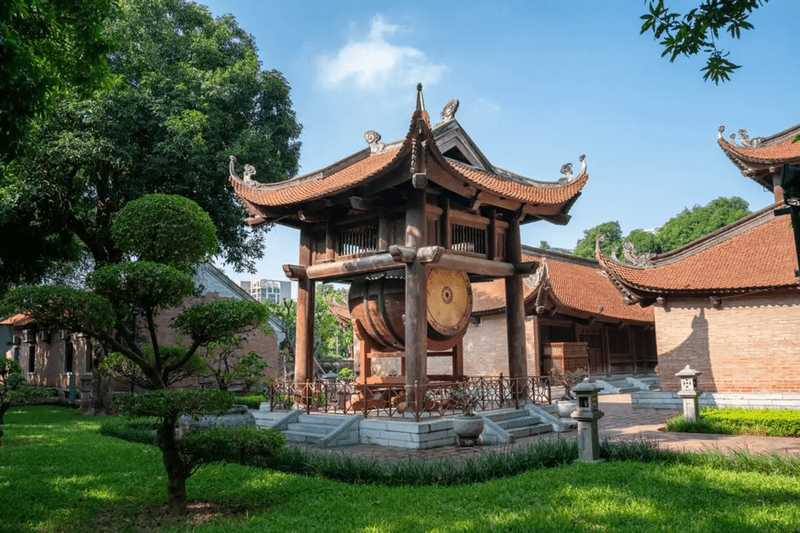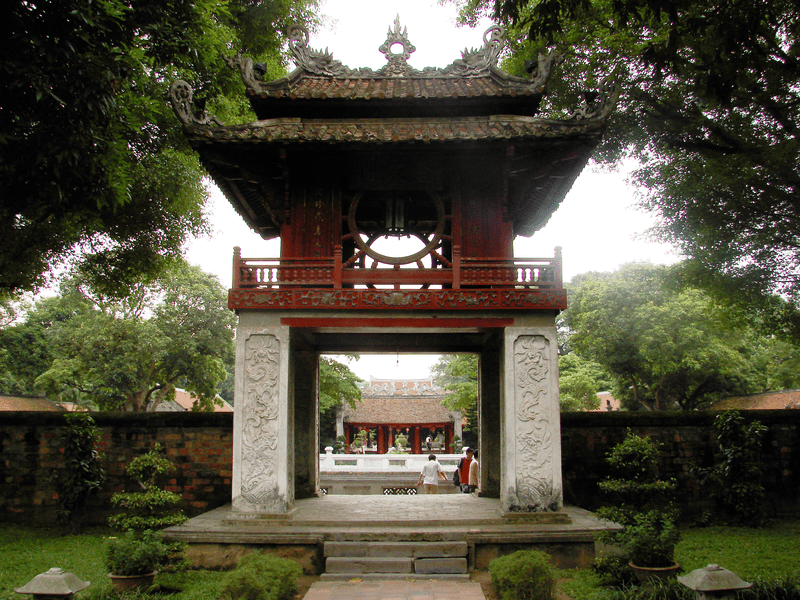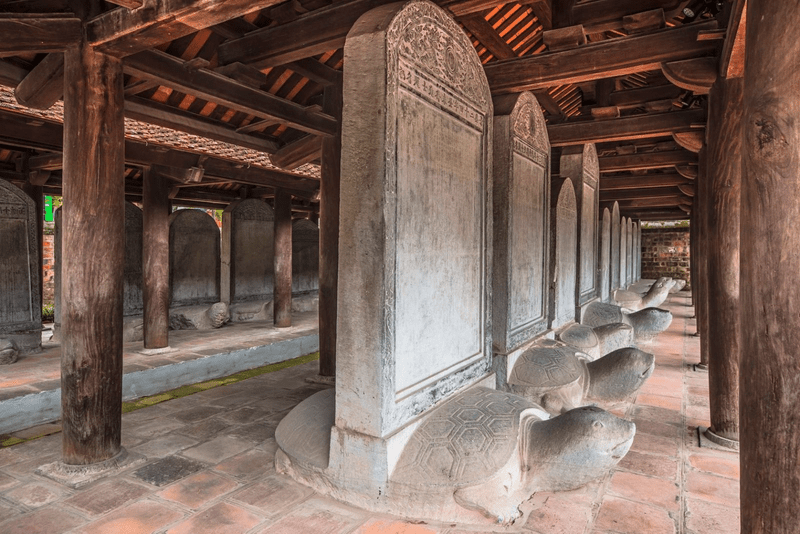See the historic and architectural wonders of the Quoc Tu Giam Temple – the very first university in Vietnam. Know its opening hours, admission fees, and practical tips to make your visit even better.
An Overview of Quoc Tu Giam Temple
Among the more interesting mixes of history, architecture, and culture listed as a UNESCO World Heritage Site has to be the Quoc Tu Giam Temple. In fact, this complex, located right in the center of Hanoi, was the very first university in Vietnam, founded in 1070 by Emperor Ly Thanh Tong. For more than seven centuries, it remained a prestigious center of learning, giving the nation a lot of its most brilliant minds.
Another legacy of the temple, other than academics, remains in its architectural beauty. It is said that its harmonious layout of multiple courtyards with intricate carvings and serene ponds speaks to the height of Vietnamese design, but many have said it is the tranquil atmosphere that draws them in, allowing this temple to transport them through time.
Stroll through the grounds, and you find much evidence of history, which includes stone stelae upon which the names of successful scholars are inscribed. The stelae are usually referred to as “Doctorate Stone Tablets,” testifying to the rigors students had to face in order to get their degrees.

How Many Courtyards Does the Temple of Literature Have?
On the inside, the Quoc Tu Giam Temple opens into five courtyards. Each has a different history and serves different purposes. Here is an explanation of these interesting spaces:
1. The Outer Gate (Outer Court)
Begin with the imperial Van Mon Gate, which serves as the entrance to the temple complex. This is a fine and impressive gate that is said to signify the threshold between the bustle of the city and the sacred grounds of learning.
2. The Khue Van Pavilion Courtyard
Stepping out of the Van Mon Gate, one would be greeted by the iconic Khue Van Pavilion, a structure plastered onto Hanoi’s postcards and popular for capturing memories. This lovely pavilion, built in the shape of the letter “The” (“university” in Vietnamese), depicts the temple’s emphasis on education.
3. The Well of Heavenly Clarity Courtyard
Further down the maze of buildings, one will reach the middle courtyard, where one finds the Giam Well. Believed to have possessed magical powers, it was used for students or even scholars as a source of water; it symbolized clarity and wisdom during their fruition of knowledge.
4. The Doctors’ Courtyard
It was dedicated to the scholars who did well in the very competitive imperial examinations. This courtyard has pavilions that honor doctors, seen as the “second parents” among the people. Here, you will find stelae containing the names of these great heroes of study and their intellectual achievements.
5. The Imperial Academy Courtyard (The Heart of the Temple)
Reaching the last courtyard, one arrives at the center of Quoc Tu Giam Temple: the Imperial Academy. It is a place where the first national university of Vietnam was established in the year 1070. Pavilions are in memorial respect to Confucius, the sages, and model students, which account for a huge legacy that contributed much to Vietnam’s intellectual tradition up to this day.

Quoc Tu Giam Temple Opening Hours and Entry Fee
The Quoc Tu Giam Temple is open to visitors daily from 8:00 AM to 5:00 PM.
Admission fees are as follows:
- Adults: 70,000 VND
- Students: 35,000 VND (valid student ID required)
Directions to Quoc Tu Giam Temple
Quoc Tu Giam Temple is located in the central area of Hanoi’s Dong Da District, with several quick and convenient traveling modes.
By Public Transportation
- Bus: The area has multiple running bus lines, with routes 2, 4, 23, 25, and 38. Take your time to look at the schedule for the most convenient stops along the way to Quoc Tu Giam.
- Taxi or Ride-Sharing: For directness and comfort, he could always resort to getting a taxi or requesting a Grab or Gojek.
By Car
If you are to go by car, the temple is situated at the intersection of Nguyen Thai Hoc, Ton Duc Thang, Van Mieu, and Quoc Tu Giam streets. You can take GPS navigation for accurate directions.
Tips:
- Consider Hanoi traffic conditions, especially peak hours, in estimating the journey.
- If you’re not familiar with the city, it might be more convenient to take a taxi or ride-sharing service.
Are you struggling finding out the best way to get to Quoc Tu Giam Temple? Don’t worry! All tours provided by Lily’s Travel will cater to all the problems about transportation and accommodation, ensuring your travel is safe and comfortable
Read more: Ho Chi Minh Museum Hanoi: A Must-Visit for History Buffs
Regulations of Quoc Tu Giam Temple
To a great extent, visitors are kindly requested to abide by these guidelines so as to preserve the tranquil environment and rich cultural heritage of the Quoc Tu Giam Temple:
- Dress Code: Dress respectfully; cover your shoulders and wear pants/trousers or a dress that reaches at least knee length.
- Quiet Behavior: A temple is an ideal place for meditation and learning. Observe complete silence to uphold the serenity of the atmosphere.
- No Food or Drink: Eating or drinking is not allowed inside the temple to help maintain its historic artifacts and keep it clean.
- Photography: Capture every moment you experience at the temple by clicking pictures, but avoid flashing for the protection of any sensitive material that may be present.
Tips for an Enjoyable Visit
In order to appreciate the visit at Quoc Tu Giam Temple, the following things should be considered:
- Guided Tour: You can hire a guide who can throw light on the temple, its history, and cultural aspects to make the visit even more valuable.
- Early Bird: Try to get up in the morning to visit the temple as early as possible to avoid crowds and experience a serene atmosphere.
- Comfortable Footwear: You need comfortable shoes, as there are a few courtyards involved with the premise of the temple.
- Time Allocation: At least one to two hours should be required of visitors to have an opportunity to view the architectural beauty and historical importance of the temple.

A visit to Quoc Tu Giam Temple offers a great deal of interesting insight into the history of the country. It speaks of the importance the country has attached to education and intellectual pursuits – from a very simple, first national university beginning to one of the historic places most loved by the nation. You can feel Vietnamese culture much more while walking in the silent courtyards and observing the detailed architecture. Whether you are interested in history, architecture, or looking for serenity, Quoc Tu Giam Temple is a never-forgetting experience. So, let’s book a Hanoi tour from Lily’s Travel and visit this enchanting site now!
Read more: One Pillar Pagoda: Hanoi Iconic Symbol















